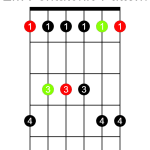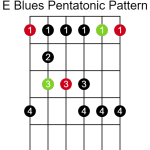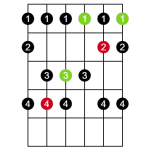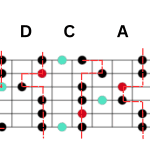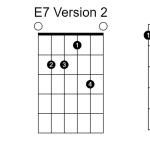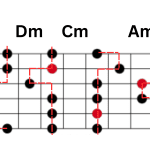Although the guitar isn’t tuned to a specific key, it does lend itself to certain keys. And because of the guitar’s unique standard tuning, one of the great keys to play guitar in is E. Because of this, it’s important to be familiar with scales in E. A lot of great songs are written in E, and Blues in E is quite prevalent. Being able to quickly play in E is a good skill to have.
If you’ve learned the minor pentatonic scale shapes, you may already be comfortable with moving this shapes up and down the guitar neck, but if you’ve had trouble translating this shapes to different positions and different keys, this guitar lesson will walk you through moving the different pentatonic scale shapes around the guitar so you can play in E in various positions.
What Are The Notes In The E Minor Pentatonic Scale?
As the name would suggest, a pentatonic scale has five notes in it. Your standard major/minor scale has eight notes in it, and the minor pentatonic scale takes five of the eight that are shared with the various minor scales. These notes are the 1st, 3rd, 4th, 5th, and 7th. So you’re not playing the 2nd and 6th notes of the scale.
Also, keep in mind that, relative to a major scale, the 3rd and the 7th are flat here.
The actual notes in the E minor pentatonic scale are E, G, A, B. and D.
How To Play The E Minor Pentatonic Scale In Different Positions On The Fret Board
If you know your pentatonic scale shapes, you’ll know there are five patterns that you can play based on the open guitar chords. You can move these patterns to have different root notes. So, for example, you can play the “D shape” in second position to play in E.
The next sections of this lesson will go through what position to play what shapes so you can play the E minor pentatonic scale all over the neck.
Playing An E Minor Pentatonic Scale In Open Position


On the diagram you’ll see I’ve marked one of the root notes in red. The other two root notes in this pentatonic scale shape occur on the open E strings.
So to play a scale in open position, play the open string, then the corresponding fret. So, on the 6th string, play it open then third fret, 6th string.
Don’t neglect learning your scales in open positions. It’s tempting to move up the neck to higher notes because it’s easier to get big bends, but a great solo, lick, or riff on the lower notes can sound surprisingly good and can be a bit unusual.
Playing An E Minor Pentatonic Scale In Second Position


Personally, I really like the D shape and feel it’s underappreciated. Some people feel like they only have four strings because the scale starts on the 4th string, even though you can use the lower string just as easily as you can play the higher string. Because of this, it’s important to practice shapes like this so you remember the pattern for the lower strings and use all the real estate you have access to.
It’s also nice playing an E minor pentatonic scale on in the second position because it’s still relatively low, but you still have good leverage and hand position to easily throw in bends and slides back to the open position.
Playing An E Minor Pentatonic Scale In Fifth Position


Like playing in the second position, you’re not too far from open position here, lending the position to some sliding back and forth. This is also a convenient position because if you’re only vaguely familiar with note finding on the guitar, you’ll know that the 7th fret is a good reference fret for finding other notes.
Basically, playing the E minor pentatonic scale in the fifth position is an easy one to hop to.
Playing An E Minor Pentatonic Scale In Seventh Position


I particularly like the A shape pentatonic scale because the minor 3rd on the 2nd string can sound real Bluesy when bent just right. It also lends itself to then going back to the root note on the 3rd string.
All that being said, I know from experience that I tend to preference the E and the A minor pentatonic shapes. You may have your own favourites, but I just find them the easiest. Break habits early and stray from what you know best. It will make you more versatile.
Playing An E Minor Pentatonic Scale In The Ninth Position


The G shape is always an interesting one because it kind of feels like an inverted E shape, but that’s just how I remember it.
Us this shape on its own or as a good way to transition all the way up to the 12th fret to play those really high notes.
And have fun!
Connecting The E Minor Pentatonic Scale Shapes
If you’ve taken a look at my article on connecting different minor pentatonic scales, you should be able to shift between all these scales easily and travel up and down the neck without trouble. The trick is to know which shape comes next in the progression as you move up and down.
For the E minor pentatonic scale, the order from lowest to highest is E shape, D shape, C shape, A shape, then G shape. Commit it to memory both backwards and forwards and you’ll be moving about in no time.
Related posts:
